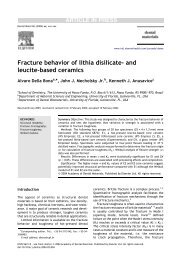Micro-tensile bond strength of adhesives bonded to class-I cavity ...
Micro-tensile bond strength of adhesives bonded to class-I cavity ...
Micro-tensile bond strength of adhesives bonded to class-I cavity ...
Create successful ePaper yourself
Turn your PDF publications into a flip-book with our unique Google optimized e-Paper software.
<strong>Micro</strong>-<strong>tensile</strong> <strong>bond</strong> <strong>strength</strong> <strong>of</strong> <strong>adhesives</strong> <strong>bond</strong>ed <strong>to</strong> <strong>class</strong>-I <strong>cavity</strong>-bot<strong>to</strong>m dentin after thermo-cycling 1005<br />
Figure 5 Feg-SEM <strong>of</strong> iBOND. (a) Pho<strong>to</strong>micrograph <strong>of</strong> the fractured surface <strong>of</strong> a control specimen (s<strong>to</strong>red mTBS<br />
specimen in water for 20 days) at the dentin side. The specimen failed mainly within the adhesive resin (Ar). A small part<br />
failed near the interface (I). (b) Pho<strong>to</strong>micrograph <strong>of</strong> the fractured surface (dentin side) <strong>of</strong> a thermo-cycling/<strong>cavity</strong><br />
specimen. The specimen failed entirely within the adhesive resin (Ar). A large part failed, however, very near <strong>to</strong> the<br />
interface (Ar–I) and appeared very porous. (c) Higher magnification <strong>of</strong> the area marked by the hand-pointer in (b). Many<br />
small porosities can be observed in the resin part close <strong>to</strong> the dentin interface (Ar–I). Also in the adhesive resin itself,<br />
some porosities can be observed. (d) Pho<strong>to</strong>micrograph <strong>of</strong> the fractured surface (dentin side) <strong>of</strong> a thermo-cycling/mTBS<br />
stick specimen. The specimen failed entirely within the adhesive resin (Ar). Again a large part failed near the interface<br />
(Ar–I) and appeared porous. (e) Composite counterpart <strong>of</strong> (d). Part <strong>of</strong> the adhesive resin chipped <strong>of</strong>f during processing<br />
(arrow) and disclosed numerous large voids within the adhesive resin. (f) Higher magnification <strong>of</strong> (e) at an area that<br />
failed near the interface. Many small porosities (0.5–7.5 mm) can be observed.<br />
regimen (20 days), one can speculate that the<br />
degradation <strong>of</strong> the interface <strong>of</strong> the thermo-cycling/<br />
stick group is caused by water exposure rather than<br />
by the thermo-cycling itself. To rule out this option,<br />
the mTBS sticks <strong>of</strong> the control group were also<br />
s<strong>to</strong>red in water for 20 days at 37 8C, this in contrast<br />
<strong>to</strong> previous studies that had 24-h controls [14,15].<br />
However, degradation caused by 20 days <strong>of</strong> water<br />
s<strong>to</strong>rage should have been minimal, as the <strong>bond</strong>s<br />
produced by three-step etch and rinse <strong>adhesives</strong><br />
and mild two-step self-etch <strong>adhesives</strong> resisted up <strong>to</strong><br />
1-year direct water exposure [16]. This assumption<br />
is substantiated by the fact that for OptiBond FL,<br />
the highest mTBS was recorded in the thermocycling/<strong>cavity</strong><br />
group, the only group not directly<br />
exposed <strong>to</strong> water for 20 days.<br />
The composite used in this study is known for its<br />
high E-modulus (21 GPa) [17]. Applying this composite<br />
in a relatively small <strong>class</strong>-I <strong>cavity</strong>, must have<br />
resulted in high polymerization shrinkage stress [7].<br />
By using a high-efficiency, high-power LED curing<br />
device, the polymerization reaction must have<br />
been rather fast, so that also the plastic flow <strong>of</strong><br />
composite, which can reduce the shrinkage stress,<br />
must have been limited. As a result, the <strong>cavity</strong><br />
model used in this study represents a clinical ‘worst<br />
case scenario’. In this study, only OptiBond FL and<br />
Clearfil Protect Bond were able <strong>to</strong> withstand the<br />
shrinkage stress in this challenging situation, in<br />
contrast <strong>to</strong> iBOND that performed unreliably.<br />
From a previous review, it was concluded that<br />
10,000 thermal cycles corresponds <strong>to</strong> 1 year in vivo<br />
degradation [2]. Therefore, the <strong>bond</strong>s produced by<br />
OptiBond FL should be durable for at least 2 years <strong>of</strong><br />
clinical service. This postulation was supported by<br />
many in vitro studies, in which OptiBond FL<br />
successfully withs<strong>to</strong>od <strong>to</strong> up <strong>to</strong> 4 years <strong>of</strong> water<br />
s<strong>to</strong>rage, thermo-cycling and/or mechanical loading<br />
[14,–16,18–20]. Only when miniature (0.4–0.6 mm 2 )<br />
mTBS specimens were aged, was a significant<br />
decrease in mTBS observed for this three-step etch<br />
and rinse adhesive [21,22]. All other types <strong>of</strong><br />
adhesive did, however, decrease at least <strong>to</strong><br />
the same extent in a similar study [23]. Also in<br />
clinical <strong>class</strong>-V studies, this three-step etch and<br />
rinse adhesive performed very reliably for up <strong>to</strong> 5<br />
years <strong>of</strong> clinical service [24,25].<br />
The <strong>bond</strong> <strong>strength</strong>s obtained with the mild twostep<br />
self-etch adhesive Clearfil Protect Bond were<br />
not significantly different from the three-step
















